Different methods applied for archiving data according to their desired lifetime
a data and lifetime technology, applied in the field of data storage, can solve the problem of relative long process, and achieve the effect of shortening the programming time and avoiding the impact of effective reliability
- Summary
- Abstract
- Description
- Claims
- Application Information
AI Technical Summary
Problems solved by technology
Method used
Image
Examples
first embodiment
[0026]Returning now to the drawings, FIGS. 3 and 4 illustrate the programming of a zero bit in a cell of an EPROM according to the present invention, in which the storage method parameter is the programming voltage increment. A train 22 of programming voltage pulses with a programming voltage increment twice as large as the programming voltage increment ΔV of FIG. 1 is applied to the cell until the threshold voltage of the cell is sufficiently close to V0. The cell of FIGS. 3 and 4 is programmed in less time than the cell of FIGS. 1 and 2, at the expense of the distribution 24 of the resulting threshold voltages around V0 being wider than distribution 16, which is shown in FIG. 3 in phantom for reference. It follows that the lower end 26 of distribution 24 drifts down to VT sooner than lower end 18 of distribution 16; but if it takes much longer than e.g. one month for lower end 26 to drift down to VT, this embodiment of the present invention is suitable for storing data, such as “c...
second embodiment
[0027]FIGS. 2 and 5 illustrate the programming of a zero bit in a cell of an EPROM according to the present invention, in which the storage method parameter is the target threshold voltage. Programming voltage pulse train 12 of FIG. 2 is applied to the cell, as in the prior art, but only until the threshold voltage reaches a target value that is sufficiently close to a voltage V0′ that is less than V0. Because V0′ is less than V0, the cell of FIG. 5 is programmed in less time than the cell of FIGS. 1 and 2, at the expense of the distribution 30 of the resulting floating gate voltages being closer to VT than distribution 16, which is shown in FIG. 5 in phantom for reference. It follows that the lower end 32 of distribution 30 drifts down to VT sooner than lower end 18 of distribution 16; but if it takes much longer than e.g. one month for lower end 32 to drift down to VT, this embodiment of the present invention is suitable for storing data, such as “cached” Web pages, that need to b...
fifth embodiment
[0030]FIGS. 3 and 7 also illustrate the programming of a zero bit in a cell of an EPROM according to the present invention, in which the storage method parameter is the maximum allowed number of programming voltage pulses. According to the prior art, pulses 14 of programming voltage pulse train 12 are applied to the cell only until the programming voltage pulse height reaches a preselected maximum Vmax. If the desired threshold voltage is not achieved, even using a programming voltage pulse 14 whose height is Vmax, the cell is deemed defective. Programming voltage pulse train 12 reaches Vmax after sixteen pulses 14. Programming voltage pulse train 34 reaches Vmax after only eight pulses 36.
PUM
| Property | Measurement | Unit |
|---|---|---|
| non-volatile memory | aaaaa | aaaaa |
| threshold voltage | aaaaa | aaaaa |
| threshold voltage V0 | aaaaa | aaaaa |
Abstract
Description
Claims
Application Information
 Login to View More
Login to View More - R&D
- Intellectual Property
- Life Sciences
- Materials
- Tech Scout
- Unparalleled Data Quality
- Higher Quality Content
- 60% Fewer Hallucinations
Browse by: Latest US Patents, China's latest patents, Technical Efficacy Thesaurus, Application Domain, Technology Topic, Popular Technical Reports.
© 2025 PatSnap. All rights reserved.Legal|Privacy policy|Modern Slavery Act Transparency Statement|Sitemap|About US| Contact US: help@patsnap.com



